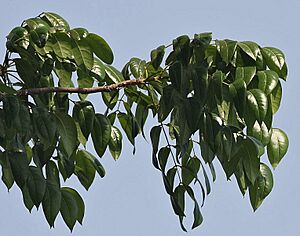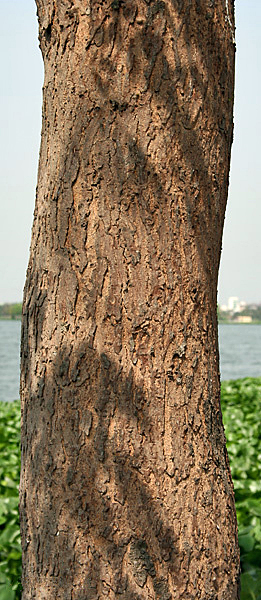American mahogany facts for kids
Quick facts for kids American mahogany |
|
|---|---|
 |
|
| Cultivated tree, India | |
| Conservation status | |
| Scientific classification | |
| Genus: |
Swietenia
|
| Species: |
mahagoni
|
| Synonyms | |
|
|
Swietenia mahagoni, also known as American mahogany or West Indian mahogany, is a special type of tree. It grows naturally in South Florida in the United States and on islands in the Caribbean Sea. These islands include the Bahamas, Cuba, Jamaica, and Hispaniola.
This tree is famous because it produces the original mahogany wood. Mahogany wood is very strong and beautiful. People also grow these trees on special farms called plantations. The wood is then sold in places like Kerala, India. Because it's so valuable, Swietenia mahagoni is now listed as "Threatened" in Florida. It is also the national tree of the Dominican Republic.
Contents
Amazing Uses of Mahogany Wood
People have been using S. mahagoni wood for a very long time. The first known use was in 1514. This date was carved into a wooden cross in a church in Santo Domingo. This church, the oldest in the West Indies, was finished around 1540. Its inside is still decorated with carved mahogany wood. It looks almost perfect even after 500 years!
Between 1521 and 1540, Spanish explorers used mahogany. They made canoes and fixed their ships with it in the West Indies. Later, in 1597, Sir Walter Raleigh used it to repair his ships.
Mahogany wood was first used in Europe for big buildings in Spain. This was before 1578. It was chosen for a very grand royal palace called El Escorial. This shows that people already knew how good mahogany was. King Philip II of Spain wanted this special wood for his palace. He asked for "rot-resistant" and "very good woods" like mahogany.
Building Ships
Mahogany was first used a lot in Spain and England for building ships. In the 1700s, it was the main wood used for ships in Europe. It was even better than oak for this purpose. Mahogany was strong and could stop cannonballs without splintering.
Ships would visit West Indies ports to pick up mahogany wood. Some pieces were so big that just one plank could make a large table. Spain needed a lot of wood for its ships. They got mahogany from places like San Domingo, Cuba, and Jamaica. Many ships of the Spanish Armada were built with West Indies mahogany.
Even 200 years later, Spain was still building ships from this wood. For example, a Spanish warship called the Gibraltar was captured by the British in 1780. When it was finally taken apart in 1836, its wood was still strong. People even made tables from its timbers!
Later, mahogany became more important for furniture. But it was still the best wood for small sailing boats. During World War II, mahogany was used a lot for small boats. This included PT boats, which were fast patrol boats. These boats were often made of thick mahogany planks. They were so strong that some survived serious battle damage. The famous PT-109, commanded by John F. Kennedy, stayed afloat for 12 hours after being hit by a Japanese destroyer!
Today, the U.S. Navy still uses mahogany for small, fast boats. It's easy to work with, strong, and doesn't shrink or warp much. It also resists decay well. For larger ships, mahogany is mostly used for inside decorations and furniture.
Making Furniture
Spanish explorers quickly saw how special West Indies Mahogany was. They started using it for furniture in the 1500s. Queen Elizabeth of England was also interested in mahogany samples.
Mahogany became very popular for furniture in Britain in the 1700s. This time is even called the "Age of Mahogany." Furniture makers in the United Kingdom, France, Spain, and Italy have used it ever since. It was also popular in American furniture design.
In the early 1900s, mahogany was used for many things. This included the inside of train cars, public buildings, hotels, and offices. It was also used for fortepianos (early pianos), scientific tools, and cases for delicate machines.
Musical Instruments
Mahogany wood is also used to make modern musical instruments. This is because it has great sound qualities.
It's sometimes used for the top, back, sides, and neck of guitars. You can also find it in older mandolins. Famous electric guitars like the Gibson Les Paul models use mahogany.
Mahogany is also used for drum shells and the wooden bars of marimbas.
Pest Control Research
Scientists have even studied if mahogany leaves and bark can help control a honey bee pest called Varroa destructor.
How We Learned About Mahogany
Before the American Revolution, European botanists explored Florida and the Bahamas. In 1729, Mark Catesby published a book with a hand-colored picture of the mahogany tree. He also wrote a description in English and French.
This description helped Carl Linnaeus name the tree Cedrela mahagoni in 1758. Two years later, Nikolaus Joseph von Jacquin reclassified it. He put the West Indies Mahogany Tree into a new group he created, called Swietenia. His classification is still used today.
What the Tree Looks Like
Swietenia mahagoni is a medium-sized tree. It can grow to be about 30 to 35 meters (100 to 115 feet) tall. It is a semi-evergreen tree, meaning it keeps most of its leaves all year.
Its leaves are long, about 12 to 25 cm (5 to 10 inches). Each leaf has four to eight smaller leaflets. The flowers are small and grow in clusters. The fruit is a woody pod, about 5 to 10 cm (2 to 4 inches) long. It holds many winged seeds.
When the tree is young, its bark is smooth and grayish. As it gets older, the bark becomes darker and has grooves. In the U.S., these trees might lose some or all of their leaves in winter. New leaves appear reddish or pinkish, then turn bright green.
In Florida, where it's at the edge of its natural range, the trees usually grow to about 10 to 15 meters (33 to 50 feet) tall.
Protecting Mahogany Trees
It's hard to find S. mahagoni wood now because too many trees were cut down. Most mahogany sold today comes from other related trees. These grow faster but their wood isn't always as good.
People also grow S. mahagoni as an ornamental tree in warm places. They plant it just for its beauty.
U.S. Federal Experimental Forest
Since 1954, the U.S. government has a special forest in St. Croix, U.S. Virgin Islands. It's 147 acres and helps study S. mahagoni trees that have grown back.
Legal Protection
West Indies Mahogany is protected by laws in Florida, the U.S. government, and international groups.
The Lacey Act of 1900 stops people from trading plants that were taken or sold illegally. The Convention on International Trade in Endangered Species (CITES) also lists S. mahagoni. This means its wood products are carefully controlled. The International Union for the Conservation of Nature (IUCN) says S. mahagoni is an Endangered tree. It is also listed as "Threatened" in Florida.
See Also




